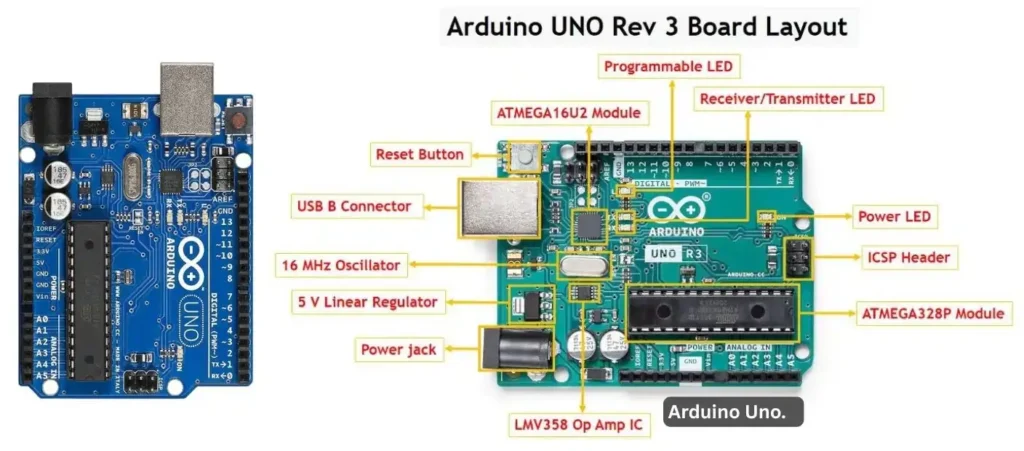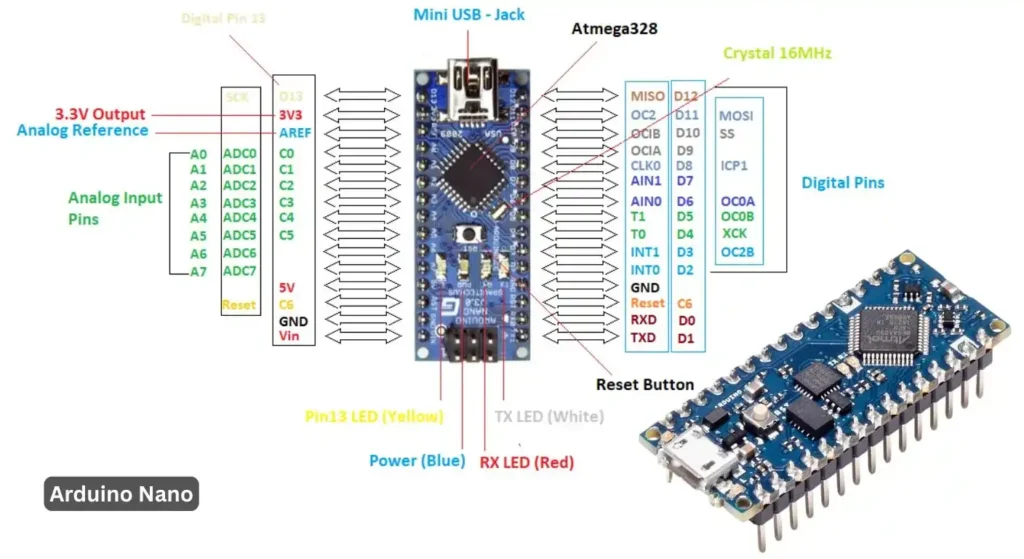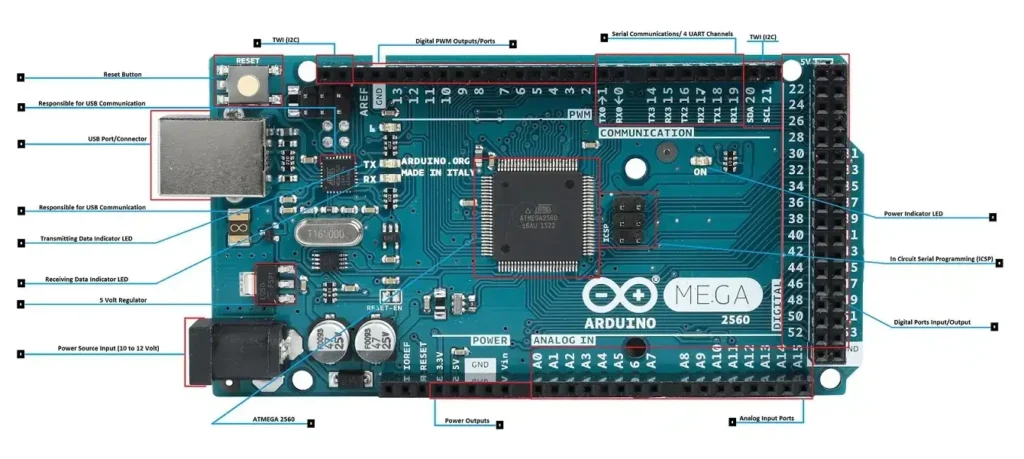Arduino microcontroller boards power countless DIY and IoT projects. The Arduino UNO, Nano, and Mega 2560 are three of the most popular models. But which one is better? It depends on your project’s needs: number of I/O pins, size constraints, memory, and budget. In this comparison of Arduino UNO vs Nano vs Mega, we’ll examine their specs, features, and ideal use cases, so you can choose the right board.
Arduino boards are widely used in Arduino projects and IoT because they easily interface with sensors and actuators. In fact, one tutorial notes that “Arduino is used in IoT (Internet of Things) since it can collect information using sensors”. Meanwhile, the Raspberry Pi offers complementary capabilities for example, you can run a raspberry pi ad blocker project or even make your own VPN using Raspberry Pi. These Pi projects highlight networking and multimedia tasks, while Arduino boards handle real-time sensor control. (For instance, an Arduino could read a temperature sensor and send data to a server, while a Pi runs a web server or camera capture.) In this article we focus on the Arduinos themselves.
Arduino UNO – The Classic Choice

The Arduino UNO is the original Arduino board and is widely regarded as the best board for beginners. It uses an ATmega328P microcontroller at 16 MHz, with 32 KB of flash program memory (of which 0.5 KB is used by the bootloader), 2 KB of SRAM, and 1 KB of EEPROM. The UNO provides 14 digital I/O pins (6 of which support PWM output) and 6 analog inputs. Power can be supplied via the USB port or an external 7-12 V DC jack. Its size (about 69×54 mm) and standard female headers make it easy to use with Arduino shields and breadboards.
Because of its simplicity and robust support, the UNO is recommended as the best Arduino UNO board for many projects. In fact, the official Arduino documentation calls the UNO “the best board to get started with electronics and coding” and notes it is “the most used and documented board of the whole Arduino family”. That means there are tons of tutorials and shields compatible with the UNO. If you’re learning Arduino or building a general-purpose project (like an LED project, sensor monitoring, or a simple robot), the UNO is usually the go-to choice.
Arduino Nano – Small and Breadboard-Friendly

The Arduino Nano offers nearly the same functionality as the UNO but in a much smaller form factor. It too typically uses an ATmega328P (16 MHz, 32 KB flash, 2 KB RAM). However, because of its tiny size (about 45×18 mm), it cannot use standard Arduino shields. Instead, it has pin headers on two sides.
The Nano usually exposes 22 digital I/O pins (6 with PWM) and 8 analog inputs more I/O pins overall than the UNO. (Note: some variants may report 14 digital and 8 analog, but the standard Nano pinout supports 22 I/O including the analog pins.) Unlike the UNO, the Nano does not have a DC power jack; it must be powered via its Mini-USB port or the 5V/Vin pin.
In short, the Nano is “essentially an Arduino UNO shrunk into a very small profile”. Its advantage is size and cost. Many sellers offer Nano clones for just a few dollars, making it often the cheapest Arduino board option. The Nano is ideal for projects where space is limited or for mounting directly on a breadboard (wearables, compact gadgets, small robots, etc.). If your project needs a lot of I/O pins but must fit in a tight enclosure, the Nano is a great choice.
Arduino Mega 2560 – Lots of I/O for Big Projects

The Arduino Mega 2560 is the big brother designed for projects requiring many I/O pins and more memory. It is built around an ATmega2560 microcontroller (16 MHz) with 256 KB of flash memory and 8 KB of SRAM and far more than the UNO/Nano’s 32 KB/2 KB. The Mega provides a whopping 54 digital I/O pins (15 with PWM) and 16 analog inputs. It has the standard USB-B port and DC jack like the UNO. Its size is about 101×53 mm.
According to the official Arduino site, The Arduino Mega 2560… has 54 digital input/output pins (of which 15 can be used as PWM outputs), 16 analog inputs, 4 UARTs (hardware serial ports), a 16 MHz crystal oscillator, a USB connection, a power jack, etc.
Essentially, the Mega is a larger UNO with vastly expanded I/O and memory. It remains compatible with most Arduino shields (since it shares the standard header layout). The Mega is ideal for complex projects like 3D printers, CNC machines, or advanced robots where you need to connect many sensors, displays, or motors.
Key Differences: UNO vs Nano vs Mega
All three boards use 5 V logic and the Arduino IDE, but they differ significantly in form factor and resources. Here’s a quick comparison:
| Feature | Uno | Nano | Mega 2560 |
|---|---|---|---|
| Microcontroller | ATmega328P | ATmega328P | ATmega2560 |
| Operating Voltage | 5V | 5V | 5V |
| Input Voltage (recommended) | 7–12V | 7–12V | 7–12V |
| Digital I/O Pins | 14 (6 PWM) | 14 (6 PWM) | 54 (15 PWM) |
| Analog Input Pins | 6 | 8 | 16 |
| Flash Memory | 32 KB (0.5 KB used by bootloader) | 32 KB (0.5 KB used by bootloader) | 256 KB (8 KB used by bootloader) |
| SRAM | 2 KB | 2 KB | 8 KB |
| EEPROM | 1 KB | 1 KB | 4 KB |
| Clock Speed | 16 MHz | 16 MHz | 16 MHz |
| USB Connector | Type B | Mini USB | Type B |
| Size | 68.6 mm x 53.4 mm | 45 mm x 18 mm | 101.52 mm x 53.3 mm |
| Breadboard Friendly | ❌ | ✅ | ❌ |
| Shield Compatibility | ✅ | ❌ | ✅ |
| Best Use Case | Beginners, General Projects | Compact Builds, Wearables, Education | Robotics, IoT Hubs, Complex Projects |
| Price | $8 – $12, ₹500 – ₹700 | $4 – $6, ₹250 – ₹400 | $10 – $15, ₹900 – ₹1,200 |
In summary, the UNO is medium-sized and well-rounded; the Nano is a compact, budget-friendly UNO; and the Mega is a large powerhouse for I/O-heavy applications.
Which Arduino is Best for You?
The answer depends on your project:
- Beginners and simple projects: Go with the Arduino UNO. Its robust design, built-in power jack, and huge community support make it the best Arduino for beginners. It’s the easiest board to use without worrying about too many pins. (The official Arduino site even calls UNO “the best board to get started with electronics and coding”.)
- Size- or pin-constrained projects: Use the Arduino Nano. If you need a lot of I/O but have very limited space (or need breadboard compatibility), the Nano is ideal. It’s tiny and cheaper, though you must manage wiring to a breadboard or PCB.
- Advanced/large projects: Choose the Arduino Mega. If your project truly needs dozens of sensors or controls (for example, complex Arduino projects like a home automation hub, or robotics with many servos and sensors), the Mega’s extra memory and pins are worth it.
- Budget builds: If cost is a concern and you can sacrifice built-in features (like the jack or headers), even cheap clones of any model will often suffice.
Keep in mind that the “best” choice often means the one that fits your use case. There’s no single winner in “Arduino UNO vs Nano vs Mega then which is better?” If you only need a handful of pins and have room, UNO is great. If you need tons of pins, Mega is better. If you have limited space, Nano wins. Sometimes hobbyists even use multiple boards together (for example, a Mega for sensors and a Nano for wireless tasks).
Arduino in IoT Projects and Beyond
Arduino boards find applications in robotics, automation, wearables, and especially IoT, because of their ease of use and sensor interfacing. You can explore many backend project ideas where an Arduino reads sensor data and sends it to a server or cloud backend (using Wi-Fi, Ethernet, or Bluetooth modules). For instance, you could build a weather station with an Arduino and log data to a home server, or control devices via a web API.
Learning Arduino also builds in-demand skills. Working with Arduino and electronics combines programming (C/C++ on a microcontroller), hardware design, and IoT concepts where all of which are part of tech skills that guarantee high-paying jobs in engineering and technology fields. Whether you’re a hobbyist or pursuing a tech career, Arduino projects teach you fundamental skills in embedded systems and IoT.
Meanwhile, don’t forget about Raspberry Pi projects as well. The Arduino and Pi often complement each other: for networking or multimedia-heavy tasks, a Raspberry Pi might be better. For example, you might unlock amazing Raspberry Pi project ideas by pairing a Pi with your Arduino and use the Pi to run complex software (even things like an ad-blocker server or VPN), while the Arduino handles real-time sensor I/O. Together, you can create sophisticated home automation, security (e.g., a camera system on a Pi with sensors on an Arduino), and more.
Recommended Arduino Boards and Accessories
Once you’ve decided which board suits your needs, here are some recommended products to get started (with Amazon as a convenient source). Prices vary by seller and brand, so consider official Arduino products for reliability or clones to save money
| Product | Description | Price | Buy Link |
|---|---|---|---|
| Arduino UNO R3 | Official Arduino UNO Rev3 board (ATmega328P, 14 digital I/O, 6 analog). Ideal for learning and general projects. | $25 (official), ~$10 (clone) | Link |
| Arduino Nano V3 | Official Nano (ATmega328P, 22 digital I/O, 8 analog). Small, breadboard-friendly. | $25 (official), ~$5 (clone) | Link |
| Arduino Mega 2560 R3 | Official Mega (ATmega2560, 54 digital I/O, 16 analog). For advanced projects needing many I/O pins. | $50 (official), ~$20 (clone) | Link |
| USB A-B Cable (Type A to B) | Standard USB cable (1-1.5 m) to connect UNO/Mega to PC for programming. | ~$5 | Link |
| USB Mini-B Cable | USB cable (Mini-B) for the Nano board (1 m). | ~$5 | Link |
| 9V DC Adapter (2.1mm) | Wall adapter (7-12 V, 1 A) with 2.1×5.5mm center-positive barrel plug. Powers UNO/Mega standalone. | ~$8-10 | Link |
Each product above can be found on Amazon; the Link goes to a typical example listing. (These are affiliate-style links – clicking and purchasing through them supports our blog.) Always double-check compatibility (voltage, plug size) when buying cables or power supplies.
Conclusion
In the UNO vs Nano vs Mega showdown, no one board is universally “best” – it depends on the application.
- Like the Arduino UNO is generally the best choice for beginners and typical projects (as its documentation notes, it’s “the most used and documented board”).
- Where as Nano offers the same core performance in a tiny, breadboard-ready form factor and is usually the cheapest option.
- And the Arduino Mega 2560, with its huge number of I/O pins and memory, is best for complex, I/O-intensive projects.
Consider your project’s requirements: number of sensors/actuators, space constraints, and power needs. Then pick the board that fits. And remember, you can combine Arduinos with other devices (like using a Pi for networking or a cloud backend) to create powerful IoT systems.
Whether you’re building a simple gadget or a sophisticated automation system, understanding the difference between Arduino Uno and Nano and Mega will help you make the right choice – and most importantly, get your project working smoothly.
Arduino Uno is a standard beginner board, Nano is compact and breadboard-friendly, and Mega offers more memory and I/O pins for complex projects. Choosing depends on your space, pin, and memory needs.
Yes, Arduino Nano uses the same ATmega328P chip as the Uno, offering identical CPU speed and memory. The Nano is just smaller and doesn’t support standard Arduino shields, making it ideal for space-constrained builds.
Choose Arduino Mega when your project demands many I/O pins or larger memory just for example, robotics, 3D printers, or home automation. It’s ideal for advanced users working on complex systems.
Arduino Uno is widely recommended for beginners. It’s easy to use, has strong community support, and fits most starter kits and tutorials. It also works great with standard shields and accessories.
Use a 9V DC barrel jack for Uno and Mega or USB power. For Nano, use a USB Mini-B cable or 5V via Vin. Always check voltage ratings to avoid damage. A stable 7-12V power supply is optimal for standalone usage.
Sources: Official Arduino documentation and spec sheets. These detail the specs and usage of UNO, Nano, and Mega.





















